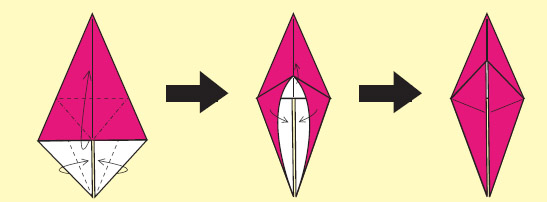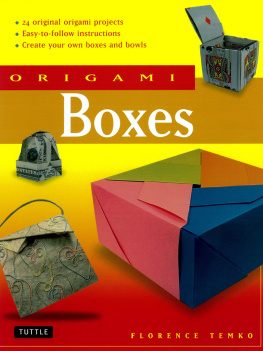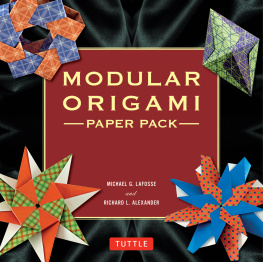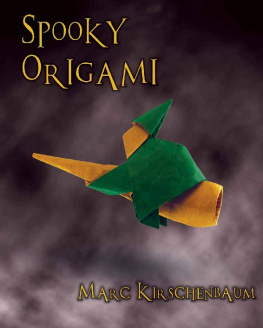ORIGAMI BASICS VALLEY FOLD

Fold the paper, forming a valley-like depression. MOUNTAIN FOLD

Fold the paper, forming a mountain-like protrusion. FOLD AND UNFOLD

Fold the paper, forming a crease. Once the crease is complete, unfold the paper back to its original position. SINK FOLD

Open the paper and invert the tip, pressing it down into the model. As you are pressing the tip down, reverse the creases surrounding the tip, forming a square of mountain folds.
SQUASH FOLD  Open up one corner of the paper, swinging what was formerly a creased edge over and pressing it down. PLEAT FOLD
Open up one corner of the paper, swinging what was formerly a creased edge over and pressing it down. PLEAT FOLD  Valley fold the top of tip down to a given point.
Valley fold the top of tip down to a given point.
Then fold the tip back up to a point slightly lower than the original position. REVERSE FOLD  Spread the top of the model and reverse the creases, mountain folding the top corner down and in. Collapse the model while pulling the reversed corner down. RABBIT EAR FOLD
Spread the top of the model and reverse the creases, mountain folding the top corner down and in. Collapse the model while pulling the reversed corner down. RABBIT EAR FOLD  Collapse one side, so that the left edges will lie even with the center crease. To do this, make two valley creases; at the point at which they meet, make another valley crease up to a corner of the paper.
Collapse one side, so that the left edges will lie even with the center crease. To do this, make two valley creases; at the point at which they meet, make another valley crease up to a corner of the paper.
The crease should thus collapse. PETAL FOLD  Bring the two sides into the center while swinging the bottom of the colored flap up, forming a point in the center of the flap. The left and right sides will now lie even with the center. REVIEW OF IMPORTANT SYMBOLS
Bring the two sides into the center while swinging the bottom of the colored flap up, forming a point in the center of the flap. The left and right sides will now lie even with the center. REVIEW OF IMPORTANT SYMBOLS 




CONTENTS

Published by Tuttle Publishing, an imprint of Periplus Editions (HK) Ltd. www.tuttlepublishing.com Copyright 2011 Periplus Edition (HK) Ltd. All rights reserved.
No part of this publication may be reproduced or utilized in any form or by any means, electronic or mechanical, including photocopying, recording, or by any information storage and retrieval system, without prior written permission from the publisher. Library of Congress Cataloging-in-Publication Data Stern, Scott Wasserman.
Outside the box origami : a new generation of extraordinary folds / Scott Wasserman Stern. -- 1st ed.
p. cm.
ISBN: 978-1-4629-0567-6 (ebook)
1. Origami. I.
Title.
TT870.S72745 2011
736.982--dc22
2010037411 Distributed by
| North America, Latin America & Europe | Japan | Asia Pacific |
| Tuttle Publishing | Tuttle Publishing | Berkeley Books Pte. Ltd. |
| 364 Innovation Drive | Yaekari Building, 3rd Floor, | 61 Tai Seng Avenue #02-12, |
| North Clarendon, | 5-4-12 Osaki, Shinagawa-ku, | Singapore 534167 |
| VT 05759-9436 U.S.A. | Tokyo 141 0032 | Tel: (65) 6280-1330 |
| Tel: 1 (802) 773-8930 | Tel: (81) 3 5437-0171 | Fax: (65) 6280-6290 |
| Fax: 1 (802) 773-6993 | Fax: (81) 3 5437-0755 | inquiries@periplus.com.sg |
| info@tuttlepublishing.com | sales@tuttle.co.jp | www.periplus.com |
| www.tuttlepublishing.com | www.tuttle.co.jp |
First edition
15 14 13 12 11 10 9 8 7 6 5 4 3 2 1
Printed in Singapore
Photography by David Cooper
TUTTLE PUBLISHING is a registered trademark of Tuttle Publishing, a division of Periplus Editions (HK) Ltd.





Paper Magic INTRODUCTION In 1922, an aging American magician published a book on origami and its uses in magic. This magician made the claim that many of the greatest magic tricks of the timethe disappearing ball, the repairing tearall had roots in the manipulation of paper. This book did more than introduce a new generation of Westerners to the ancient Japanese art of origami. It showed how far origami had come in modern societypermeating even the highest echelons of American entertainment.
After all, the books title was Houdinis Paper Magic , and the aging magician was none other than Harry Houdini.  I was first introduced to origami when I was three years old. Masumai, a teacher at the preschool I attended, folded simple origami for the children; I was fascinated by the paper animals that took her minutes to make. Masumai taught me my first origami model: the simple camera. After that, I began to attend the Origami Club of Pittsburgh (OCOP) on a semi-regular basis. I learned enthusiastically and started buying basic origami books without restraint.
I was first introduced to origami when I was three years old. Masumai, a teacher at the preschool I attended, folded simple origami for the children; I was fascinated by the paper animals that took her minutes to make. Masumai taught me my first origami model: the simple camera. After that, I began to attend the Origami Club of Pittsburgh (OCOP) on a semi-regular basis. I learned enthusiastically and started buying basic origami books without restraint.















 Fold the paper, forming a valley-like depression. MOUNTAIN FOLD
Fold the paper, forming a valley-like depression. MOUNTAIN FOLD  Fold the paper, forming a mountain-like protrusion. FOLD AND UNFOLD
Fold the paper, forming a mountain-like protrusion. FOLD AND UNFOLD  Fold the paper, forming a crease. Once the crease is complete, unfold the paper back to its original position. SINK FOLD
Fold the paper, forming a crease. Once the crease is complete, unfold the paper back to its original position. SINK FOLD  Open the paper and invert the tip, pressing it down into the model. As you are pressing the tip down, reverse the creases surrounding the tip, forming a square of mountain folds.
Open the paper and invert the tip, pressing it down into the model. As you are pressing the tip down, reverse the creases surrounding the tip, forming a square of mountain folds.  Open up one corner of the paper, swinging what was formerly a creased edge over and pressing it down. PLEAT FOLD
Open up one corner of the paper, swinging what was formerly a creased edge over and pressing it down. PLEAT FOLD  Valley fold the top of tip down to a given point.
Valley fold the top of tip down to a given point. Spread the top of the model and reverse the creases, mountain folding the top corner down and in. Collapse the model while pulling the reversed corner down. RABBIT EAR FOLD
Spread the top of the model and reverse the creases, mountain folding the top corner down and in. Collapse the model while pulling the reversed corner down. RABBIT EAR FOLD  Collapse one side, so that the left edges will lie even with the center crease. To do this, make two valley creases; at the point at which they meet, make another valley crease up to a corner of the paper.
Collapse one side, so that the left edges will lie even with the center crease. To do this, make two valley creases; at the point at which they meet, make another valley crease up to a corner of the paper. Bring the two sides into the center while swinging the bottom of the colored flap up, forming a point in the center of the flap. The left and right sides will now lie even with the center. REVIEW OF IMPORTANT SYMBOLS
Bring the two sides into the center while swinging the bottom of the colored flap up, forming a point in the center of the flap. The left and right sides will now lie even with the center. REVIEW OF IMPORTANT SYMBOLS 










 I was first introduced to origami when I was three years old. Masumai, a teacher at the preschool I attended, folded simple origami for the children; I was fascinated by the paper animals that took her minutes to make. Masumai taught me my first origami model: the simple camera. After that, I began to attend the Origami Club of Pittsburgh (OCOP) on a semi-regular basis. I learned enthusiastically and started buying basic origami books without restraint.
I was first introduced to origami when I was three years old. Masumai, a teacher at the preschool I attended, folded simple origami for the children; I was fascinated by the paper animals that took her minutes to make. Masumai taught me my first origami model: the simple camera. After that, I began to attend the Origami Club of Pittsburgh (OCOP) on a semi-regular basis. I learned enthusiastically and started buying basic origami books without restraint.